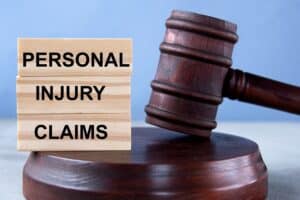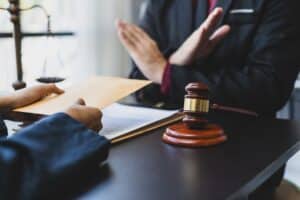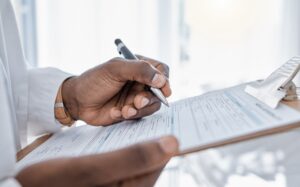A personal injury lawsuit is a legal action that an individual who has been harmed due to another party’s negligence or wrongdoing can file in the court system. The key steps in a personal injury lawsuit include filing a complaint, serving the at-fault party (the defendant), engaging in discovery, negotiating a settlement, and possibly going to trial or alternative dispute resolution.
A Phoenix personal injury attorney can provide invaluable assistance throughout this process by gathering evidence, negotiating with insurance companies, and representing the accident victim in court. Their legal knowledge and experience help to ensure that victims receive fair compensation for medical expenses, lost income, and emotional distress resulting from their injuries.
Types of Personal Injury Cases
Personal injury cases arise when individuals suffer harm due to the negligent or wrongful actions of others. Here are some of the most common categories:
- Car Accidents – Car accidents often result from distracted driving, speeding, or driving under the influence. Victims may face physical injuries, emotional distress, and financial burdens due to medical bills and lost earnings. Determining liability can involve multiple parties, such as other drivers or even the vehicle manufacturer.
- Truck Accidents – Types of truck accidents can be more severe than car accidents due to the size and weight of commercial vehicles. Factors contributing to truck accidents include driver fatigue, improper loading, and equipment failures. Victims of truck accidents often face significant medical expenses and long recovery times. These cases can involve multiple liable parties, including the truck driver, trucking company, and vehicle manufacturers.

- Product Liability – Product liability cases arise when defective products injure consumers. This can involve design flaws, manufacturing defects, or insufficient safety warnings. Common examples include faulty electronics, dangerous toys, and harmful pharmaceuticals. To succeed in a product liability case, the injured party must prove that the product was defective and that the defect caused their injuries.
- Medical Malpractice – Medical malpractice occurs when healthcare providers fail to meet the accepted standard of care, leading to patient harm. Common issues include misdiagnosis, surgical errors, and improper treatment. Victims may experience worsened medical conditions, requiring further treatment and incurring additional costs. Establishing malpractice requires proving that the healthcare provider’s actions directly caused the injury and fell short of professional standards.
- Pedestrian Accidents – Pedestrian accidents happen when vehicles collide with individuals on foot. These accidents can result from driver negligence, such as ignoring crosswalks or failing to yield. Pedestrians often sustain serious injuries from falling on the ground or striking another vehicle.
- Motorcycle Accidents – Motorcycle crashes often lead to severe injuries due to the lack of protection for riders. Factors like visibility issues and reckless driving may contribute to these accidents. Riders may seek compensation for medical bills, pain and suffering, and lost income.
- Bicycle Accidents – Bicycle accidents involve cyclists being hit, often resulting from driver negligence. Cyclists can suffer serious injuries, and cases may revolve around the driver’s failure to share the road safely.
Successfully Settling a Personal Injury Claim
Successfully settling a personal injury claim involves a detailed process. Here’s a breakdown of the key steps and how a lawyer can assist throughout.
- Investigating the Accident Circumstances – The first step is to investigate the circumstances of the accident. This involves gathering crucial evidence, such as police reports, witness statements, and photographs of the scene. A personal injury lawyer can help by identifying what information is necessary and can often coordinate with investigators or experts to gather evidence effectively. They understand what details are critical to establishing liability and can provide guidance on local laws that may affect the case.
- Gathering Documentation – Once the investigation is complete, the next step is to gather all relevant documentation. This includes medical records, bills, and proof of lost earnings. A personal injury attorney can assist by advising on which documents are most pertinent and ensuring that everything is organized. They can also communicate with medical providers to obtain necessary records, making the process smoother for the injured party. Additionally, documenting the effects of the injuries on daily life, including emotional distress, can be challenging, and a lawyer can determine how to best present this information.
- Submitting a Claim to the At-Fault Party’s Insurance Company – After compiling all of the necessary documentation, the next step is to submit a claim to the at-fault party’s insurance company. A lawyer can draft a comprehensive demand letter that clearly outlines the details of the accident, the injuries sustained, and the compensation sought. Their experience in writing such claim letters can make a significant difference in how the insurance company perceives the case. A well-structured demand is more likely to receive serious attention from the insurer.
- Negotiating with the At-Fault Party’s Insurance Company – Negotiation is often the most critical phase in the settlement process. Insurance adjusters may initially offer a low settlement offer, which may not adequately reflect the damages. A lawyer’s experience in negotiation is invaluable here, as they can provide a realistic assessment of the claim’s value based on medical expenses, lost income, and pain and suffering. Having a lawyer present during negotiations can deter lowball offers and ensure that the injured party’s rights are protected.
The process of settling a personal injury claim is complex and can be overwhelming. A lawyer’s assistance ensures that the injured party navigates the process effectively.
What Happens During a Personal Injury Lawsuit?
Filing a personal injury lawsuit is a structured process that involves several key steps. Understanding these steps can help victims navigate the legal system more effectively.
- Filing a Complaint – The first step in filing a personal injury lawsuit is to file a complaint in the appropriate court. This document outlines the accident victim’s (plaintiff’s) allegations against the defendant, including the facts of the case, the legal basis for the claim, and the damages sought. The complaint must be filed within the statute of limitations, which varies by state, so it’s important to act promptly.
- Serving the Defendant – Once the complaint is filed, the next step is to serve the defendant with a copy of the complaint and a summons. This legally notifies the defendant that they are being sued and provides them with a timeframe to respond. Proper service is necessary, as failure to do so can result in delays or dismissal of the case.

- The Defendant’s Response – After being served, the defendant typically has a specified period to respond, usually by filing an answer or a motion to dismiss. In the answer, the defendant may admit or deny the allegations and may also present any counterclaims against the plaintiff. If the defendant files a motion to dismiss, the court will review it and determine whether the case can proceed.
- Discovery Phase – If the case continues, the discovery phase begins. This involves both parties exchanging information and evidence related to the case. Discovery methods include written interrogatories, requests for documents, and depositions, where witnesses are questioned under oath. This phase is critical for building a strong case, as it allows both sides to gather relevant facts and assess the strengths and weaknesses of their positions.
- Pre-Trial Motions – After discovery, either party may file pre-trial motions. These motions can address various issues, such as seeking to dismiss the case or requesting summary judgment, which asks the court to rule in favor of one party without going to trial. The court will review these motions and issue rulings that can shape the course of the lawsuit.
- Trial or Alternative Dispute Resolution – If the case is not resolved through settlement or pre-trial motions, it will proceed to trial. During the trial, both parties present their evidence and arguments to a judge or jury, who will then make a decision on both fault and damages. Alternatively, parties may choose alternative dispute resolution methods, such as mediation or arbitration, to settle the case outside of court. These methods can often be less formal, quicker, and less expensive than a traditional trial.
Important Evidence in a Personal Injury Lawsuit
In a personal injury lawsuit, evidence plays an important role in establishing liability and demonstrating the extent of damages. The types of evidence presented can significantly influence the outcome of the case. Here are some of the most important types of evidence commonly used in personal injury lawsuits.
- Medical Records – Medical records are one of the most critical types of evidence in personal injury cases. They provide documentation of the injuries sustained, the treatment received, and the prognosis for recovery. These records can include hospital bills, physician reports, and therapy notes. They help establish a direct link between the accident and the injuries claimed, making them essential for proving damages.
- Accident Reports – Accident reports – or police reports – are also vital pieces of evidence. These reports provide an official account of the incident, including details about the circumstances leading up to it, the parties involved, and any citations issued. They can help clarify liability and support the plaintiff’s version of events.
- Photographic Evidence – Photographs taken at the accident scene or of the injuries can be powerful evidence. Images of vehicle damage, the accident location, and visible injuries provide visual context that can strengthen the plaintiff’s claims. Photographs can also capture conditions like weather, road hazards, or signage that may have contributed to the incident.

- Witness Statements – Eyewitness testimony can significantly bolster a personal injury case. Statements from individuals who saw the incident can provide objective accounts of the events. Having multiple witnesses can strengthen the case further.
- Expert Testimony – In some cases, expert testimony may be necessary to explain complex issues related to the case, such as medical conditions, accident reconstruction, or safety standards. Experts can provide professional opinions that help clarify the extent of injuries or the mechanisms of the accident, adding credibility to the plaintiff’s claims.
- Documentation of Lost earnings – Evidence of lost income is important for establishing economic damages. This can include pay stubs, tax returns, or letters from employers confirming the time missed due to injuries. Documenting how the injury has affected the plaintiff’s ability to work and earn income is essential for a comprehensive damages claim.
Gathering and presenting the right types of evidence is critical in a personal injury lawsuit. Effective use of this evidence can significantly influence the outcome of the case.
Damages You Can Recover in a Personal Injury Lawsuit
In a personal injury lawsuit, victims can recover different types of damages, which are divided into economic and non-economic categories. Economic damages refer to measurable financial losses that a victim experiences due to an injury. These can include:
- Medical Expenses – This includes all costs related to medical treatment, such as hospital bills, surgeries, medication, physical therapy, and any future medical care needed.
- Lost income – If the injury causes the victim to miss work, they can claim lost earnings. This includes not only the salary for the time missed but also any potential future earnings if the injury affects their ability to work long-term.
- Property Damage – If personal property, such as a vehicle, was damaged in the accident, the victim may recover costs for repairs or replacement.
- Other Out-of-Pocket Expenses: This may include costs like transportation to medical appointments, home care services, or any other expenses incurred because of the injury.
Non-economic damages cover more subjective losses that are harder to quantify. These can include:

- Pain and Suffering – This refers to the physical pain and emotional distress resulting from the injuries. It can include both current suffering and any long-term effects on the victim’s quality of life.
- Emotional Distress – Many injuries lead to anxiety, depression, or other psychological issues. Victims can seek compensation for these emotional hardships.
- Loss of Consortium – If the injuries affect the relationship between spouses, the uninjured partner may claim damages for loss of companionship or intimacy.
- Loss of Life Enjoyment – If an injury prevents a person from participating in activities they once enjoyed, they may be compensated for this loss.
In some cases, the court may award punitive damages in addition to economic and non-economic damages. Punitive damages are intended to punish the defendant for particularly reckless or malicious behavior and to deter similar actions in the future. These damages are not based on the victim’s actual losses but rather on the severity of the defendant’s conduct.
Call a Skilled Personal Injury Lawyer Today
A skilled personal injury attorney can guide you through the process of filing a claim or lawsuit seeking the compensation you deserve. Your attorney will file the necessary documentation in a timely manner, negotiate on your behalf, and represent you during various legal proceedings in pursuit of the maximum monetary compensation you need.